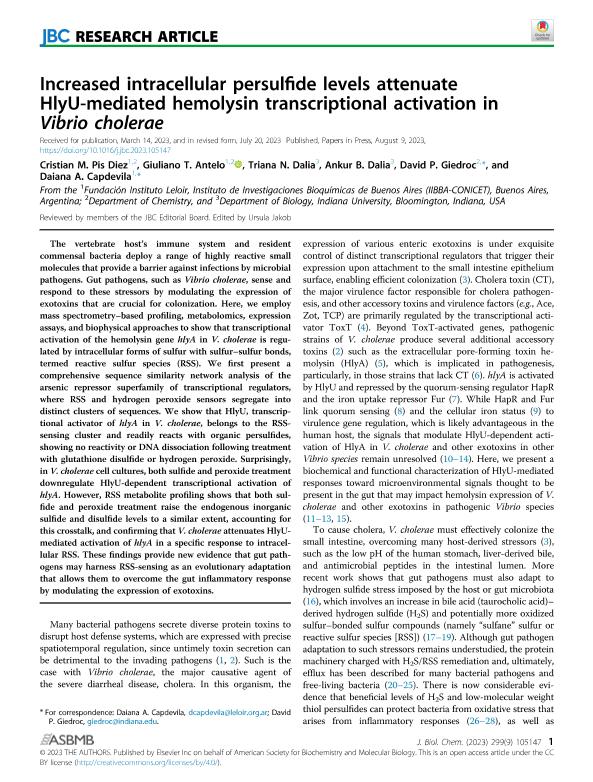Artículo
Increased intracellular persulfide levels attenuate HlyU-mediated hemolysin transcriptional activation in Vibrio cholerae
Pis Diez, Cristian Manuel ; Antelo, Giuliano Tomás
; Antelo, Giuliano Tomás ; Dalia, Triana N.; Dalia, Ankur B.; Giedroc, David Peter; Capdevila, Daiana Andrea
; Dalia, Triana N.; Dalia, Ankur B.; Giedroc, David Peter; Capdevila, Daiana Andrea
 ; Antelo, Giuliano Tomás
; Antelo, Giuliano Tomás ; Dalia, Triana N.; Dalia, Ankur B.; Giedroc, David Peter; Capdevila, Daiana Andrea
; Dalia, Triana N.; Dalia, Ankur B.; Giedroc, David Peter; Capdevila, Daiana Andrea
Fecha de publicación:
09/2023
Editorial:
American Society for Biochemistry and Molecular Biology
Revista:
Journal of Biological Chemistry (online)
ISSN:
0021-9258
Idioma:
Inglés
Tipo de recurso:
Artículo publicado
Clasificación temática:
Resumen
The vertebrate host's immune system and resident commensal bacteria deploy a range of highly reactive small molecules that provide a barrier against infections by microbial pathogens. Gut pathogens, such as Vibrio cholerae, sense and respond to these stressors by modulating the expression of exotoxins that are crucial for colonization. Here, we employ mass spectrometry–based profiling, metabolomics, expression assays, and biophysical approaches to show that transcriptional activation of the hemolysin gene hlyA in V. cholerae is regulated by intracellular forms of sulfur with sulfur–sulfur bonds, termed reactive sulfur species (RSS). We first present a comprehensive sequence similarity network analysis of the arsenic repressor superfamily of transcriptional regulators, where RSS and hydrogen peroxide sensors segregate into distinct clusters of sequences. We show that HlyU, transcriptional activator of hlyA in V. cholerae, belongs to the RSS-sensing cluster and readily reacts with organic persulfides, showing no reactivity or DNA dissociation following treatment with glutathione disulfide or hydrogen peroxide. Surprisingly, in V. cholerae cell cultures, both sulfide and peroxide treatment downregulate HlyU-dependent transcriptional activation of hlyA. However, RSS metabolite profiling shows that both sulfide and peroxide treatment raise the endogenous inorganic sulfide and disulfide levels to a similar extent, accounting for this crosstalk, and confirming that V. cholerae attenuates HlyU-mediated activation of hlyA in a specific response to intracellular RSS. These findings provide new evidence that gut pathogens may harness RSS-sensing as an evolutionary adaptation that allows them to overcome the gut inflammatory response by modulating the expression of exotoxins.
Archivos asociados
Licencia
Identificadores
Colecciones
Articulos(IIBBA)
Articulos de INST.DE INVEST.BIOQUIMICAS DE BS.AS(I)
Articulos de INST.DE INVEST.BIOQUIMICAS DE BS.AS(I)
Citación
Pis Diez, Cristian Manuel; Antelo, Giuliano Tomás; Dalia, Triana N.; Dalia, Ankur B.; Giedroc, David Peter; et al.; Increased intracellular persulfide levels attenuate HlyU-mediated hemolysin transcriptional activation in Vibrio cholerae; American Society for Biochemistry and Molecular Biology; Journal of Biological Chemistry (online); 299; 9; 9-2023; 1-17
Compartir
Altmétricas



